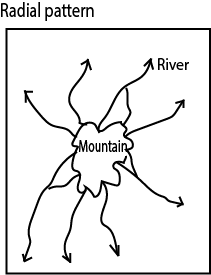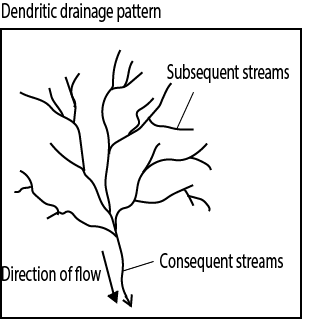
Distinguish between radial and dendritic drainage patterns.

Radial drainage pattern
This is a drainage pattern where several rivers originate from the same source/ central point and flow outwards to different directions down the flanks of dome or cone- shaped hill/ mountain/ upland.

Process of Formation/ causes of radial drainage
- Presence of a dome or cone shaped highland such as a volcanic cone/mountain or highland provides the source of the .
- Nature of the Radial drainage is greatly controlled by the presence of steep slope which accelerates downward movement and erosion of rocks to create channels along which the rivers flow.
- High precipitation in the catchment area in form of rainfall, snow or the melting of glaciers is important for the development of radial drainage Such precipitation provides a constant supply of water needed for the development of the rivers.
- es of Radial drainage patterns are found on Mt Elgon where Rivers Sironko, Manafwa, Sipi, Namatala, etc.; on Mt.Rwenzori where R. Mubulru, Nyamugasani, Lume and Ruanoli originate. It’s also found on Mt Kenya, Kilimanjaro and Meru.
Dendritic drainage pattern:
- This is a drainage pattern where the main river and its tributaries resemble a structure of a tree or a leaf. It’s a tree-like pattern where tributaries converge on the main stream from many directions and usually join the main river at an acute angle e. less than 90°.
- Examples are found on R.Rufigi,. Victoria Nile,. R. Malagalasi, Ruvuma, in. Tanzania and River Nyando, Congo, Nzoia, Kagera, Katonga, Aswa, Okok, Mara etc.

Conditions for development of dendritic drainage pattern are:
- They develop in areas with uniform rock structure and hardness (homogenous rocks). Such patterns are common on the crystalline granitic It enables the rivers to erode with minimum effort.
- Dendritic pattern also develop on gently dipping/ sloping landscape of sedimentary strata. Each tributary flows in a valley proportional to its size or volume of water and maintains its flow.
- Dendritic pattern develop in regions which receives heavy and reliable rainfall. That’s why it’s most prominent in the equatorial / tropical regions where there is heavy and reliable rainfall to support the development of multiple tributaries.
- In relation to slope, all the consequent and subsequent streams flow in the direction of the initial slope of the area over which the area was established
- Dendritic drainage pattern develops in a common large catchment area. The multiple tributaries cover a larger catchment area.
- Dendritic pattern develops on gently sloping areas where the entire major streams (Consequent) and subsequent (minor) streams flow in the direction of the initial slope of the area over which the pattern was established.
- Consequent streams develop head ward erosion and minor (subsequent) streams develop in the similar manner and join the main tributaries to complete the pattern.
CATEGORIES Geography
TAGS Dr. Bbosa Science
